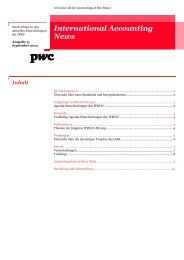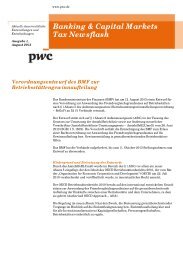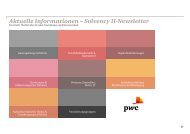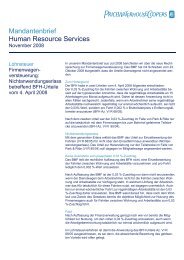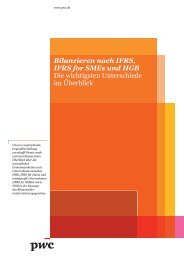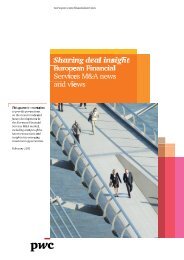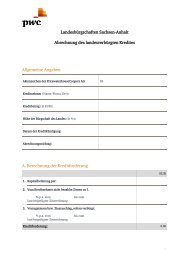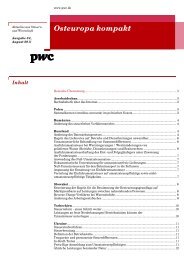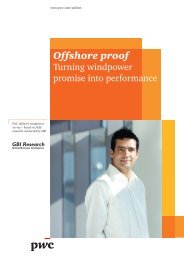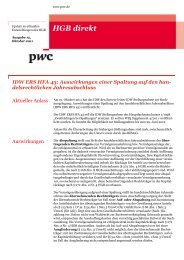Emerging Trends in Real Estate® Europe 2012 - PwC
Emerging Trends in Real Estate® Europe 2012 - PwC
Emerging Trends in Real Estate® Europe 2012 - PwC
You also want an ePaper? Increase the reach of your titles
YUMPU automatically turns print PDFs into web optimized ePapers that Google loves.
has gone from 2 to 3 percent <strong>in</strong> the boom years to around 11<br />
or 12 percent by 2019. So capital <strong>in</strong>creases mean two th<strong>in</strong>gs<br />
(1) do less f<strong>in</strong>anc<strong>in</strong>g go<strong>in</strong>g forward and (2) marg<strong>in</strong>s will have<br />
to be very considerably higher. At a time when shortage of<br />
debt f<strong>in</strong>anc<strong>in</strong>g is a major issue, this comb<strong>in</strong>ation is almost<br />
untenable.” A German mortgage lender commented, “The<br />
choice you have is either to <strong>in</strong>crease equity or to reduce the<br />
balance sheet total, which is the choice between Scylla and<br />
Charybdis.”<br />
“There is a huge gap between the amount of debt that<br />
needs to be ref<strong>in</strong>anced and the amount of debt available from<br />
the banks to do the job. The impact of Basel III is potentially<br />
huge—so huge, <strong>in</strong> fact, that I th<strong>in</strong>k that it will be watered<br />
down at the last m<strong>in</strong>ute. There is not enough equity to bolster<br />
the banks, so they will have to sell vast quantities of assets<br />
to meet the regulatory requirements. This will reduce asset<br />
values, which means that they will need to sell more assets.<br />
Some solution will be found that will allow the banks to extend<br />
and pretend for a bit longer.”<br />
One banker summed up the broader impact of Basel III: “It<br />
was right for regulators to consider how banks functioned. But<br />
now you reap what you sow, and if you want safer banks, then<br />
this has implications <strong>in</strong> the wider economy.”<br />
Solvency II. Those <strong>in</strong>terviewed for this report widely recognised<br />
that the implementation of the Solvency II regulations for<br />
<strong>Europe</strong>an <strong>in</strong>surance companies is of huge significance for the<br />
real estate <strong>in</strong>dustry. Life <strong>in</strong>surance companies are major <strong>in</strong>vestors<br />
<strong>in</strong> real estate as an asset class. Furthermore, the <strong>Europe</strong>an<br />
Insurance and Occupational Pensions Authority has started a<br />
consultation process due to be completed <strong>in</strong> January regard<strong>in</strong>g<br />
the extension of a Solvency II–type regime to some or all<br />
def<strong>in</strong>ed-benefit pension schemes. Such a regime will potentially<br />
have an even greater impact for the real estate <strong>in</strong>dustry<br />
than the application of the rules to <strong>in</strong>surance companies.<br />
The key concern for the real estate <strong>in</strong>dustry is how <strong>in</strong>surers<br />
and possibly pension funds will view real estate as an<br />
<strong>in</strong>vestment asset once Solvency II is <strong>in</strong> force, and <strong>in</strong> particular,<br />
how they will be required to model potential future falls <strong>in</strong><br />
value of their <strong>in</strong>vestments. One <strong>in</strong>terviewee commented: “As<br />
an <strong>in</strong>surer, we are go<strong>in</strong>g to be directly impacted by Solvency<br />
II. It is not great for direct <strong>in</strong>vestment, but the treatment of<br />
funds looks as though it is be<strong>in</strong>g clarified <strong>in</strong> a way that works<br />
for us, mirror<strong>in</strong>g the treatment that we already adopt. We are<br />
worried about the modell<strong>in</strong>g of currency risks and that this<br />
might encourage people to stay at home rather than <strong>in</strong>vest<strong>in</strong>g<br />
abroad. As a big <strong>in</strong>surer, we are go<strong>in</strong>g to be us<strong>in</strong>g our own<br />
<strong>in</strong>ternally generated model rather than the standard model set<br />
out <strong>in</strong> the regulations. All this means less change for us.”<br />
Not all <strong>in</strong>terviewees saw the <strong>in</strong>creased pressure on <strong>in</strong>surers<br />
as a negative. As one Dutch <strong>in</strong>vestor observed, “Solvency<br />
II will take money away from the equity market. This is a plus:<br />
despite the meagre economic outlook, there is too much<br />
money chas<strong>in</strong>g too few deals, result<strong>in</strong>g <strong>in</strong> high prices.”<br />
Chapter 2: <strong>Real</strong> Estate Capital Markets<br />
Alternative Investment Fund Managers<br />
Directive. The AIFMD will make real estate fund management<br />
a regulated activity <strong>in</strong> the EU. A major step forward<br />
on this front occurred dur<strong>in</strong>g the <strong>in</strong>terview period for this<br />
<strong>Emerg<strong>in</strong>g</strong> <strong>Trends</strong> report. The <strong>Europe</strong>an Securities and<br />
Markets Authority published on 16 November 2011 its longawaited<br />
f<strong>in</strong>al technical advice that will implement the AIFMD,<br />
which is a significant milestone <strong>in</strong> the progress of the legislation.<br />
Although not required to adopt all the technical advice,<br />
the <strong>Europe</strong>an Commission is expected to follow it closely <strong>in</strong><br />
develop<strong>in</strong>g the implementation measures.<br />
Interviewees generally regarded the AIFMD’s impact as<br />
of major importance but slightly less critical than the changes<br />
affect<strong>in</strong>g banks and <strong>in</strong>surance companies. As one <strong>in</strong>terview ee<br />
commented: “Solvency II is potentially game chang<strong>in</strong>g.<br />
Everyth<strong>in</strong>g else is just a big hassle. Life is <strong>in</strong>creas<strong>in</strong>gly full of<br />
po<strong>in</strong>tless hassle, and this is just another example. Nobody<br />
can get a competitive advantage from this; it just drags everyone<br />
down together.”<br />
Not everyone agreed that no opportunity exists for competitive<br />
advantage. A number of <strong>in</strong>terviewees from bus<strong>in</strong>esses<br />
that are already regulated felt they would be able to cope more<br />
easily. As one put it: “Regulation will be a huge issue for the<br />
real estate <strong>in</strong>dustry. Direct regulation, <strong>in</strong> the form of the AIFMD,<br />
is probably a competitive advantage for us. We are part of an<br />
<strong>in</strong>surance company, so are already used to a heavi ly regulated<br />
environment and have the <strong>in</strong>frastructure <strong>in</strong> place to deal<br />
with regulation. For others from an unregulated world, this<br />
is go<strong>in</strong>g to be a real challenge.” Another <strong>in</strong>terviewee noted,<br />
“Larger players should have a competitive advantage due to<br />
scale, and this is likely to lead to consolidation <strong>in</strong> the <strong>in</strong>dustry<br />
across the EU.” The consequence of this advantage was also<br />
remarked on by others, a Dutch <strong>in</strong>terviewee comment<strong>in</strong>g,<br />
“The adm<strong>in</strong>istrative burden of the AIFMD will prevent new creative<br />
start-ups and kill small niche players: <strong>in</strong> ten to 15 years<br />
from now, the fund management bus<strong>in</strong>ess will consist of only<br />
larger managers, all provid<strong>in</strong>g the same uniform services. It<br />
will kill the fun <strong>in</strong> explor<strong>in</strong>g new ventures.”<br />
Availability of Debt<br />
After a period that one <strong>in</strong>terviewee described as “the banks<br />
have just been kick<strong>in</strong>g the can along the street,” <strong>in</strong>terviewees<br />
gave a very def<strong>in</strong>ite sense that a major change is underway,<br />
both <strong>in</strong> terms of the restructur<strong>in</strong>g of exist<strong>in</strong>g debt and for the<br />
provision of new debt.<br />
As far as new debt is concerned, those <strong>in</strong>terviewed or those<br />
who completed the onl<strong>in</strong>e survey showed little optimism. The<br />
overwhelm<strong>in</strong>g consensus among survey respondents is that<br />
debt will be less available <strong>in</strong> <strong>2012</strong>. A small m<strong>in</strong>ority took the<br />
view that debt would be more available, but this view was not<br />
shared by lenders. No lender thought that more debt would<br />
be available, and only 6 percent thought the availability of<br />
debt would even rema<strong>in</strong> the same. The rema<strong>in</strong><strong>in</strong>g 94 percent<br />
<strong>Emerg<strong>in</strong>g</strong> <strong>Trends</strong> <strong>in</strong> <strong>Real</strong> Estate ® <strong>Europe</strong> <strong>2012</strong><br />
17



